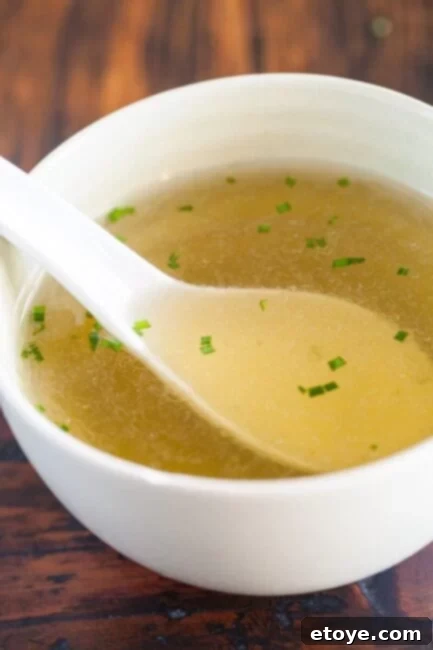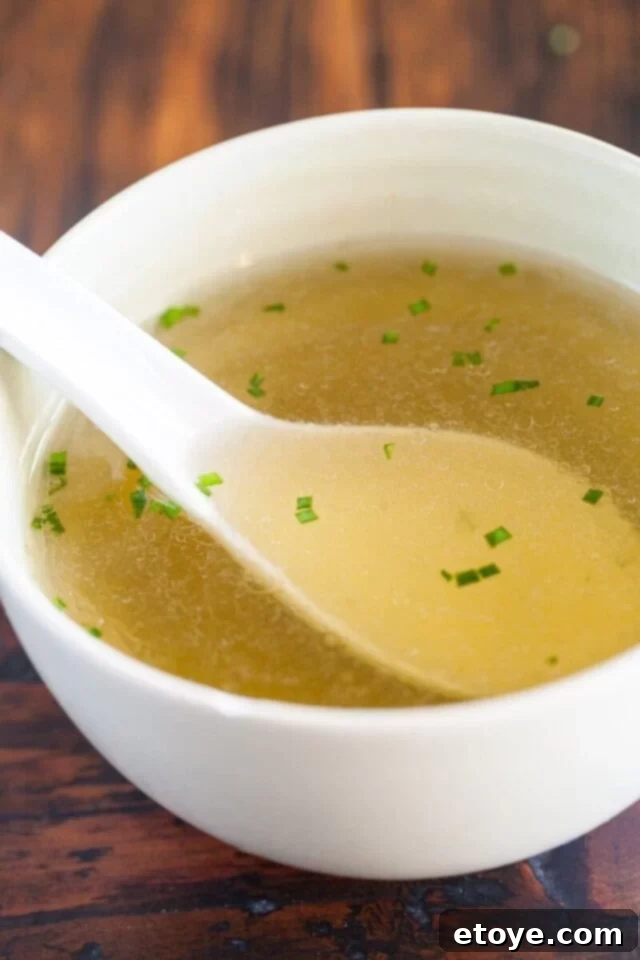
Nourishing Traditions: Crafting Asian-Style Bone Broth in Your Slow Cooker
In many Asian cultures, soup isn’t just a side dish; it’s a fundamental part of daily life and a cornerstone of family meals. From the comforting warmth of a traditional Japanese breakfast featuring a bowl of Miso Soup to the extensive list of house soups offered in Chinese restaurants – ranging from appetite-stimulating Hot and Sour Soup to light, palate-cleansing broths served at the end of a meal – soups and broths play a pivotal role. They offer comfort, nutrition, and a sense of continuity that transcends generations.
I grew up with the comforting aroma of soup always simmering on the stove. My mother ensured a Chinese-style soup graced our dinner table every single night. It became a cherished ritual for me to save the soup for last, savoring each spoonful as the perfect conclusion to a delightful, home-cooked meal. This tradition instilled in me a deep appreciation for the art of broth-making and its significance in our culinary heritage.
As an adult navigating a busy, active lifestyle, replicating my mother’s hours-long stove-top simmering isn’t always practical. Modern life demands efficiency without sacrificing the essence of homemade goodness. This is where the slow cooker becomes an indispensable kitchen tool. With a large 6-quart slow cooker, we can effortlessly create an authentic Asian-style bone broth that provides nourishing meals for our family throughout the entire week, bringing those cherished flavors and health benefits into our contemporary lives.
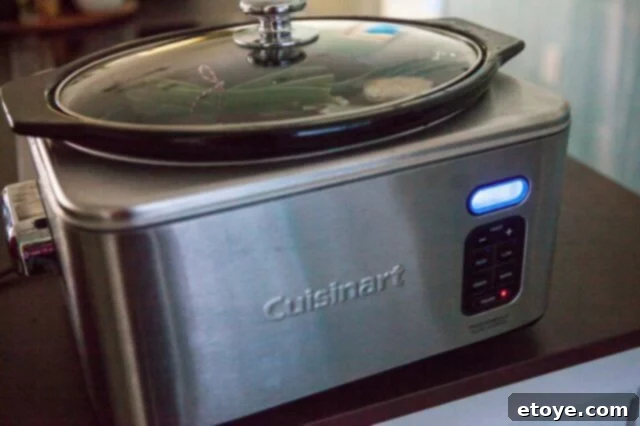
What Exactly is Bone Broth? The Elixir of Health
Bone broth is a truly ancient and revered preparation, celebrated for its incredible nutritional density and profound health benefits. Unlike standard broths, bone broth is gently simmered for extended periods—typically 24 hours or even longer—to meticulously extract a vast array of beneficial compounds from animal bones. Whether derived from fish, chicken, pork, or beef, this prolonged cooking process meticulously breaks down bones, connective tissues, and marrow, releasing a powerhouse of vital nutrients.
Among these invaluable components are essential vitamins, an abundance of collagen, and critical minerals like calcium phosphate. Collagen, in particular, is a protein vital for healthy skin, hair, nails, and joints, making bone broth a popular choice for those seeking natural beauty and wellness support. It’s no wonder bone broth has surged in popularity recently, moving beyond traditional kitchens to become a wellness trend. You’ll find upscale restaurants serving drive-through bone broth in coffee cups for a premium, dedicated cookbooks exploring the art of bone broths (like the highly recommended The Nourished Kitchen Cookbook), and even convenient lines of bone broth concentrates available for purchase. This resurgence highlights a renewed appreciation for this humble yet powerful elixir.
Unraveling the Differences: Broth, Stock, Bone Broth, and Soup
While often used interchangeably, the terms “broth,” “stock,” “bone broth,” and “soup” actually refer to distinct culinary preparations, each with unique characteristics determined by their ingredients and cooking times. Understanding these distinctions is key to appreciating the depth and nutritional value of true bone broth.
- Soup: Generally the broadest category, soups are versatile concoctions made with a variety of ingredients, including meats, bones, an assortment of vegetables, herbs, and sometimes added grains. They can be thickened with starches and are typically simmered for a couple of hours, resulting in a hearty, often opaque, and flavorful meal in itself.
- Broth: Lighter in comparison, broths are usually prepared from meat (or vegetables) and aromatic ingredients, simmered for a relatively short period, typically one to two hours. The goal is to extract flavor rather than profound nutritional content from bones. The result is a clear, light-colored, and delicately flavored liquid, often used as a base for other dishes or consumed on its own.
- Stock: Often considered an intermediate between broth and bone broth, stock is primarily made from bones (often roasted for deeper flavor), a small amount of meat, and mirepoix (carrots, celery, onions). It’s typically simmered longer than broth, around 3-6 hours, to extract more collagen, giving it a richer body when cooled (it will often gelatinize). Stock is a foundational ingredient in many culinary preparations, contributing body and depth.
- Bone Broth: Standing apart, bone broths are characterized by their exceptionally long cooking times—a full day or even significantly longer. This extended simmering (24+ hours) is crucial for maximizing the extraction of nutrients like collagen, gelatin, amino acids, and minerals directly from the bones and connective tissues. The result is a profoundly rich, deeply flavorful, and highly nutritious liquid. This is why the pho broth at your favorite Vietnamese restaurant is likely simmered overnight; its incredible richness and depth are a testament to this lengthy, patient process.
The extended cooking time of bone broth is what truly sets it apart, allowing it to yield an unparalleled concentration of nutrients and flavor. How can you tell when you’ve achieved maximum extraction? When the bones themselves become so tender and demineralized that they literally disintegrate with just a little pressure from your fingers. This is the mark of a truly potent and health-boosting bone broth.

The Art of Slow Cooker Bone Broth: Asian Style for Everyday Wellness
Embracing the wisdom of traditions while adapting to modern schedules, our method for preparing Asian-style bone broth leverages the convenience of a slow cooker. This approach, inspired by the concept of “perpetual soup” popularized by Nourished Kitchen, allows us to maintain a continuous supply of this nourishing elixir throughout the week. The journey begins on Sunday night, as the slow cooker quietly performs its magic, transforming simple ingredients into a rich, golden liquid overnight.
By morning, we greet the day with a warm, restorative bowl of bone broth as part of our breakfast. The beauty of this “infinite bone broth” method is its dynamic nature: each day, after drawing off some broth for consumption, we replenish the pot with fresh water, allowing the slow cooker to continue its gentle hum. This continuous process doesn’t just maintain supply; it deepens the broth’s character.
As the week progresses, we introduce new layers of flavor. Perhaps a fresh vegetable, a change of aromatic herbs, or a selection of umami-boosting Asian ingredients. This daily refresh ensures that the broth evolves, developing an increasingly richer, smoother, and fuller profile with each passing day. More importantly, it continuously extracts the valuable nutrition locked within the bones, providing a steady stream of health benefits.
Serving the broth offers another opportunity for customization. Some days, we might garnish it with a sprinkle of freshly chopped herbs, a handful of shredded seaweed, or even a spoonful of leftover rice for a more substantial start to the day. This adaptable approach makes bone broth a versatile and essential component of our daily diet, blending tradition with modern-day practicality.
Secrets to Achieving a Perfectly Clear and Flavorful Bone Broth
Crafting exceptional bone broth, especially an Asian-style one, involves a few key principles that ensure both clarity and maximum flavor extraction. It’s a gentle art, not a vigorous cooking process.
- Be Gentle and Avoid Violent Boiling: The essence of quality bone broth lies in a slow, gentle simmer. Avoid aggressive, rolling boils. High heat can emulsify fats and proteins, leading to a cloudy, less appealing broth. A gentle “bubble” on low heat is perfect, coaxing out flavors and nutrients without agitation.
- Resist the Urge to Stir: Especially after the first couple of days, refrain from stirring the pot too vigorously. By this point, the bones will have softened considerably, and aggressive stirring can cause them to crumble into tiny fragments. This results in a gritty texture that detracts from the broth’s smoothness and clarity.
- Utilize Herb/Tea Bags or Cheesecloth for Small Ingredients: To maintain a clean broth and simplify the straining process, enclose small herbs, finely chopped aromatics, or spices like whole peppercorns or star anise in cheesecloth sachets or reusable herb/tea bags. This prevents you from having to painstakingly dig through the broth to fish out tiny particles, ensuring a pure liquid.
- Diligent Skimming for Clarity: This step is critical, particularly during the initial 6-8 hours of cooking. Use a very fine-mesh skimmer to regularly remove the “scum” that rises to the surface. This foam consists of denatured proteins, impurities, microscopic bone fragments (especially if the bones were cut), and excess oils. Removing it promptly is essential for achieving a beautifully clear and clean broth.
- The “Infinite Bone Broth” Method – Seeding the Next Batch: Ready to start a new batch? Don’t pour out all your hard-earned liquid gold. Reserve a portion of your deeply concentrated broth to “seed” your next batch. This technique, also used by restaurants for broths, sauces, and sourdough, jumpstarts the flavor development, infusing your new creation with the rich, complex profile you’ve already built. It’s a perpetual cycle of deliciousness and nourishment.
Crafting Chinese Bone Broth: The Flavor Foundation
The heart of Chinese cooking often relies on what’s affectionately known as the “holy trinity” of aromatics: garlic, ginger, and green onion. These three ingredients form the foundational flavor profile for countless dishes, and they are absolutely essential for an authentic Chinese-style bone broth.

To avoid the tedious task of fishing out small pieces of ingredients from the broth, I employ a few smart techniques. A whole head of garlic, for instance, is simply cut in half. Sometimes the cloves will separate, but for any loose cloves or other small spices, I highly recommend using bags designed for DIY teabags or herb pouches. These inexpensive pouches (often 100 bags for around $5-$6) are incredibly practical.

Simply fill the pouch with your loose garlic cloves, whole peppercorns, star anise, or any other small aromatics that would be difficult to retrieve. Fold the top over, and everything stays neatly contained. You can also create your own sachets using a piece of cheesecloth tied with kitchen twine.
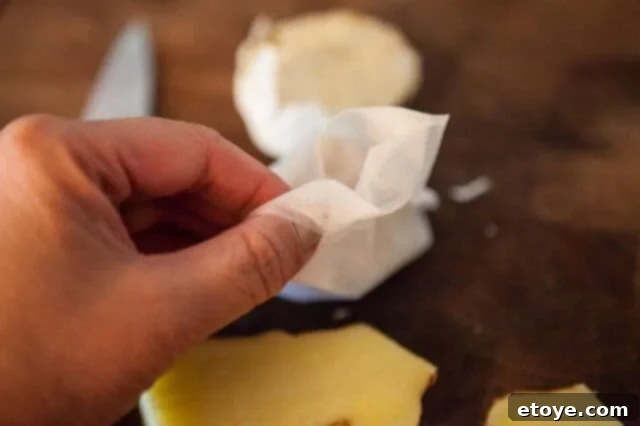
For green onions, tying them together with twine ensures easy removal once their flavor has been extracted. A substantial knob of ginger is sliced in half. I strategically reserve the other half of the ginger, the remaining garlic cloves (often in an herb pouch), and more green onion to add to the bone broth a couple of days into the simmering process. This staggered addition ensures fresh, vibrant aromatic notes are continually infused into the broth; I simply discard the spent herbs and replace them with new ones.
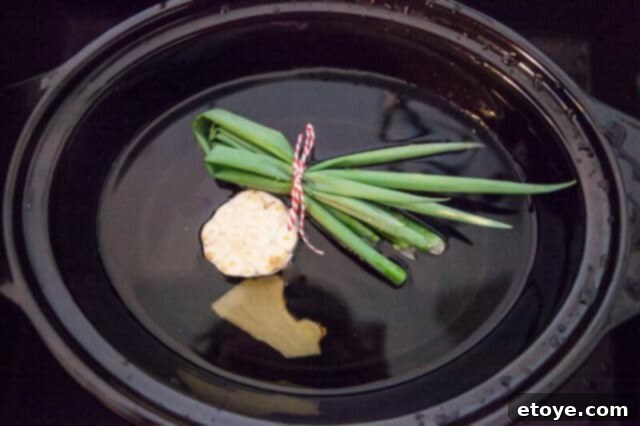
This week, my choice of bones is spareribs, which were conveniently on sale. Pork broth holds a significant place in Chinese cuisine, enjoying a popularity comparable to that of chicken broth in Western kitchens. Many of the Chinese soups I prepare begin with pork bones due to their ability to produce a lighter, more neutral-flavored broth compared to the richer, bolder profiles of beef or chicken. This neutrality allows other delicate flavors to shine through beautifully.

Some prefer to trim off any excess fat from the spareribs before cooking, but I typically leave it on. The beauty of the slow-cooker method, combined with diligent skimming, means any surface oils and fats can be easily removed later without compromising the flavor or texture of the broth.
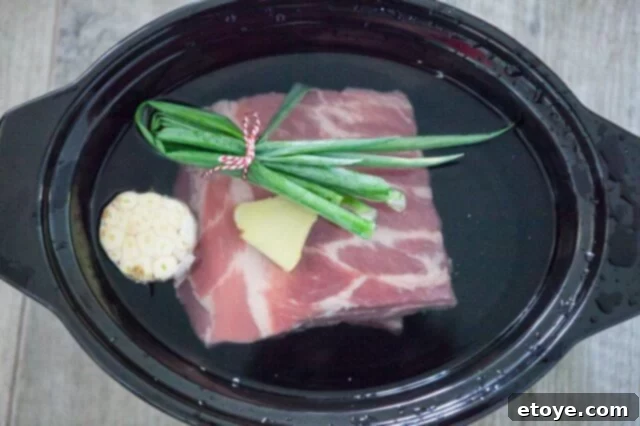
Once all your chosen bones and aromatics are in the slow cooker, fill it with water to about an inch below the rim, set it to low, and let it work its magic. If you plan to make slow cooker bone broth regularly, investing in the largest slow cooker you can find is a wise decision. My Cuisinart 6 1/2 Quart Slow Cooker has been a reliable workhorse, consistently delivering excellent results.
After a few hours, the initial “scum” will begin to rise to the surface. This is your cue to skim. I use a very fine-mesh skimmer for this task. Its incredibly tight mesh effectively captures not only surface particles but also most of the oils and fats, ensuring your broth remains clear and clean. This crucial step contributes significantly to the broth’s final appearance and mouthfeel.
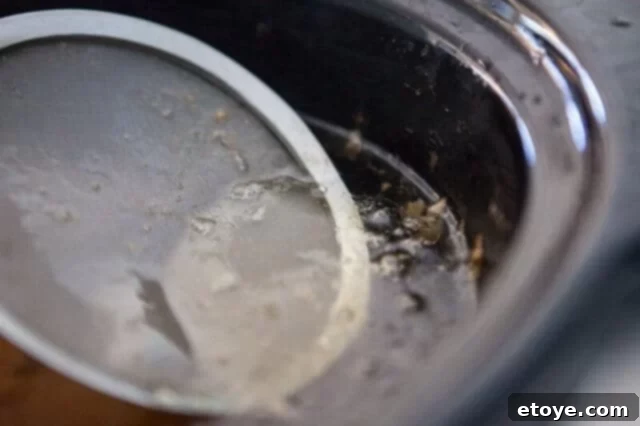
The next morning, you’ll be greeted by a wonderfully rich and aromatic bone broth. At this point, it’s ready for its initial seasoning. Taste your broth and adjust with salt or fish sauce to your preference, allowing the flavors to truly sing.
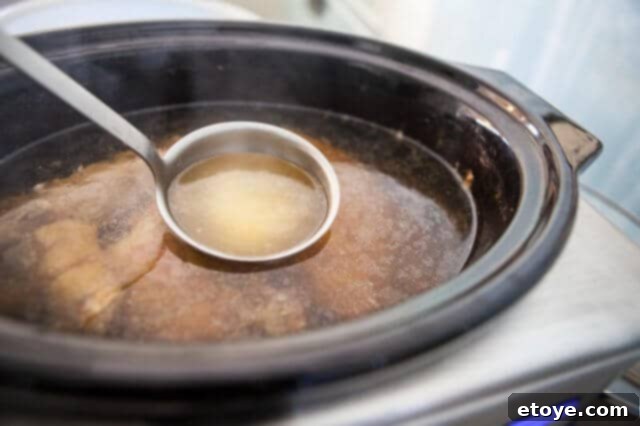
As part of the perpetual broth method, I discard the spent green onion, garlic, and ginger, replacing them with fresh aromatics. For instance, this time, I’m enhancing the broth with fragrant garlic chives and vibrant cilantro straight from our garden. Again, I tie these delicate herbs into bundles to facilitate easy removal later, preventing any unwanted grittiness in the broth.

After enjoying a portion, remember to top off the slow cooker with fresh water. The beauty of this method is its continuous nature; the slow cooker remains on low throughout the week, constantly producing nourishing bone broth.
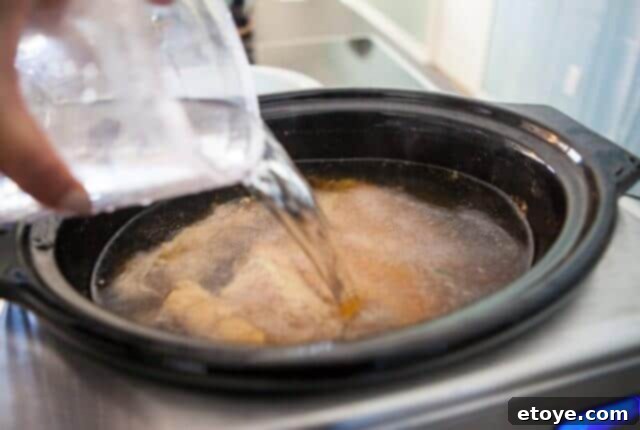
Enhancing Chinese Bone Broth with Dried Delicacies and Vegetables
To further deepen the flavors and introduce rich umami notes into your Chinese bone broth, consider incorporating traditional dried ingredients after a couple of days of simmering. These items pack a concentrated punch of flavor that beautifully complements the bone broth base:
- Dried Scallops: These tiny, intensely flavorful gems impart a profound seafood sweetness and umami.
- Dried Shrimp: Offering a delicate oceanic essence, dried shrimp add another layer of savory depth.
- Dried Black Mushrooms (Shiitake): Rehydrated shiitake mushrooms provide an earthy, robust flavor and a wonderful aroma.
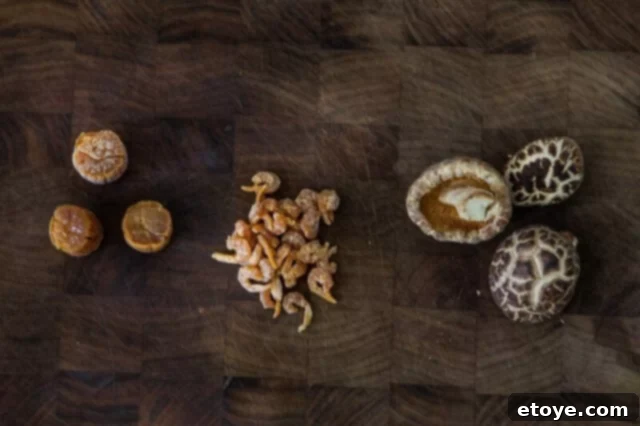
For a comforting and healthy home-style soup, you can also add sliced daikon radish and carrots. This combination creates one of my absolute favorite traditional Chinese soups. Every visit back to my mother’s house inevitably includes a request for her famous Daikon Carrot Soup, a testament to its simple yet profound deliciousness.
If you’re a cilantro lover, don’t discard the stems! Cilantro stems possess just as much, if not more, concentrated flavor than the leaves and are perfect for infusing soups and broths with their distinctive aroma.
Diving into Japanese Bone Broth: Umami-Rich Flavors
To infuse your bone broth with the delicate yet profound flavors characteristic of Japanese cuisine, consider adding a few key ingredients known for their umami-boosting properties:
- Kombu: Introduce a small, 6-inch piece of dried kombu (seaweed). Kombu provides a deep, savory, and naturally salty flavor that forms the backbone of many Japanese broths. A fantastic tip for kombu: it can often be reused multiple times! Simply rinse it, wipe it clean, and allow it to dry completely before storing it for its next use.
- Bonito Flakes: For an extra layer of smoky, fishy umami, add a handful of bonito flakes (katsuobushi). These dried, smoked, and fermented skipjack tuna flakes should be placed within an herb or tea bag to prevent them from disintegrating into the broth and making it cloudy.
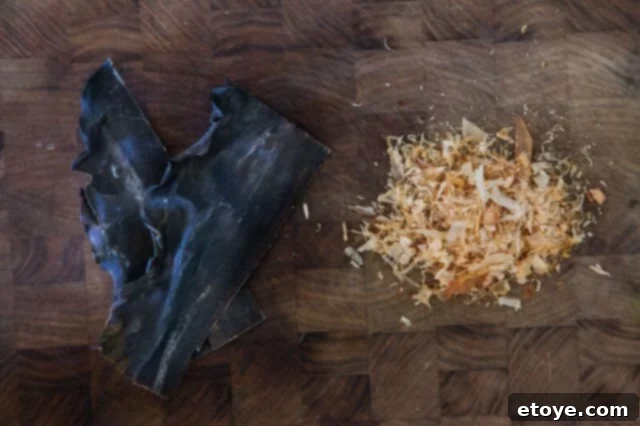
One of my favorite ways to enjoy Japanese-inspired bone broth is as a wholesome breakfast. A spoonful of leftover rice or grains topped with roasted seaweed, specifically Kizame Nori (sliced, roasted seaweed), creates a simple yet deeply satisfying meal. Have you ever tried Ochazuke, a similar dish where green tea is poured over rice?

If you wish to fortify your Japanese bone broth with miso paste, it’s crucial to add it separately and off the heat. Miso paste, when cooked at high temperatures or for too long, can lose its delicate flavor and beneficial probiotics, and even become gritty. To incorporate miso, ladle some of your finished bone broth into a separate saucepan. If the broth isn’t already hot from the slow cooker, bring it to a gentle simmer, then immediately turn off the heat. Whisk in just a couple of tablespoons of miso paste until fully dissolved. Be mindful of the amount, especially if you’ve already seasoned your broth with salt. I personally favor shiro miso (white miso paste) for its milder, less salty profile compared to other varieties. Always remember: miso paste is a finishing touch, added only after the heat has been removed.
Creating Vietnamese Bone Broth: The Essence of Pho
For a truly aromatic and iconic Vietnamese bone broth, specifically a pho-inspired one, the right blend of spices is paramount. These spices, when gently infused, create the complex and deeply satisfying flavor that pho is famous for.
Gather your essential pho spices and place them securely into a mesh bag or a tea bag to prevent them from scattering throughout the broth. Typical pho spice packs include star anise, cinnamon sticks, black cardamom pods, cloves, and coriander seeds. (For a full recipe, explore this Slow Cooker Vietnamese Pho recipe.)
Many Asian markets conveniently offer pre-packaged “Pho Spice Packs,” making it incredibly easy to gather all the necessary aromatics. Simply add the spice bag to your slow cooker alongside your beef bones (which benefit greatly from being roasted first for a richer flavor) and let the slow cooker work its magic.
Instead of seasoning with regular salt, a key characteristic of Vietnamese bone broth is its seasoning with fish sauce. Start with a tablespoon, taste, and then add a teaspoon at a time until you achieve the perfect balance of savory depth and umami. The quality of fish sauce makes a significant difference. My free “Asian Masters of Flavor” ebook reveals my top brand recommendation, highlighting the vast difference between a good quality, naturally fermented fish sauce and inferior, chemical-laden alternatives.

Practical Tips and Sustainable Living for Broth Lovers
Making bone broth in a slow cooker continuously throughout the week might raise concerns about electricity consumption. However, it’s reassuring to know that running a slow cooker costs mere pennies per day, making it an incredibly energy-efficient way to nourish your family.
For those passionate about fresh ingredients, consider embracing sustainable practices. We are fortunate to grow most of our own herbs and many vegetables in our aquaponics garden and greenhouse. This not only ensures a constant supply of fresh, organic produce but also connects us more deeply to our food sources.

A simple yet effective tip for green onions: you can easily grow your own, even starting from store-bought varieties. Select green onions that have robust, healthy, and slightly wet roots. Simply plant them in soil, and they will continue to develop their root system and sprout new leaves. Instead of buying new bunches, just snip off the leafy parts you need, and new growth will emerge throughout the entire growing season, providing a continuous harvest.
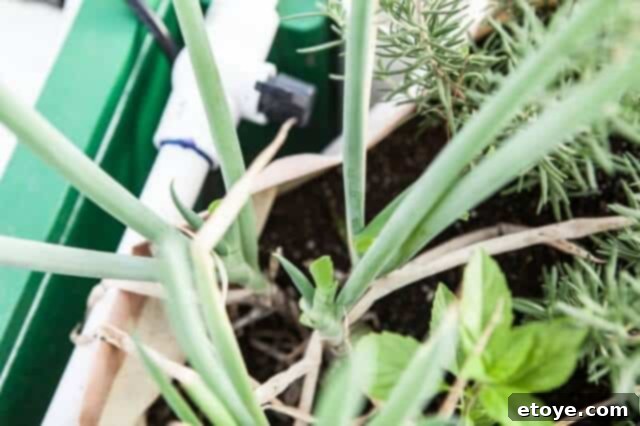
Recommended Cooking Equipment for Bone Broth Success
Having the right tools can make all the difference in your bone broth journey. Here are a few essential pieces of equipment that will enhance your experience:
- Large Slow Cooker: As mentioned, a spacious slow cooker like the Cuisinart 6 1/2 Quart Slow Cooker is invaluable for making large batches that last all week.
- Very Fine Mesh Skimmer: Crucial for achieving a clear broth, a high-quality fine-mesh skimmer will effectively remove scum, fat, and small particles.
- DIY Teabags / Herb Pouches: For containing small aromatics and spices, these disposable or reusable pouches are incredibly convenient.
Explore More Asian Soup and Broth Recipes
If you’ve enjoyed making this Asian-style bone broth, you might also like to explore these other nourishing and flavorful recipes:
- Vietnamese Pho Pressure Cooker – Paleo Friendly
- Mom’s Chinese Chicken Soup
- Vegetable Thai Curry Noodle Soup
- Tofu and Mushroom Miso Soup
- Chinese Daikon and Carrot Soup
- 15 Minute Udon Miso Noodle Soup
- Thai Fish Soup
- Soba Noodles in Shiitake-Shoyu Broth with Spring Vegetables
- Spicy Korean Seafood Soup
Slow Cooker Bone Broth Recipe – Asian Style
This recipe provides a versatile foundation for various Asian bone broth styles. For Chinese or Japanese variations, pork or chicken bones are preferred. If you opt for beef bones, excellent for Vietnamese bone broth, roasting them at 350°F for 30 minutes before adding to the slow cooker will yield a richer, deeper flavor. This step is not typically necessary for pork or chicken bones, which can be added raw. Always choose grass-fed, organic bones for the best quality and nutritional value.
Bone Type Recommendations:
- PORK: Spareribs, neck bones, hocks, or any other pork bones.
- CHICKEN: A whole raw chicken, the frame of a rotisserie chicken, chicken wings, or chicken feet. Turkey bones also work wonderfully.
- BEEF: Oxtail, knuckle bones, neck bones, or short ribs. Beef bone marrow can also be used, but after roasting, I recommend spooning out most of the marrow to spread on bread with sea salt, as too much marrow can make the broth taste greasy. Short ribs add exceptional flavor to any beef bone broth.
- FISH: Fish bones and heads. For a traditional Chinese style, pair with garlic, generous amounts of ginger, and green onion. Remove fish skin and the thin, silvery lining in the gut area to avoid a strong “fishy” taste. If using raw fish bones, roasting them at 350°F for 20 minutes can temper the fishiness. Most non-oily fish varieties are suitable.
Ingredients
- 4 pounds spareribs (or other chosen bones)
- 1 head garlic, halved
- 1 big knob of fresh ginger (about the size of 2 fingers), halved
- 3-4 stalks green onions, cut in half
- Water, to fill slow cooker
- Salt or fish sauce, to taste
Instructions
- Reserve half of the garlic, ginger, and green onion for later use in the week. Tie the green onion bundles with twine for easy removal.
- In a slow cooker, combine the bones (if roasting beef/fish bones, add after roasting), along with half of the green onion, garlic, and ginger. Fill the slow cooker with water, leaving about 1 inch of space from the rim.
- Set the slow cooker to high heat initially. Once the broth begins to simmer, typically after an hour or so, a layer of “scum” will form on the surface. Skim and discard this scum diligently to ensure a clear broth.
- After skimming, reduce the slow cooker setting to low and allow the bone broth to cook for a minimum of 6 hours, or preferably overnight (12-24 hours) for maximum nutrient extraction.
- Use a fine-mesh skimmer periodically to remove any remaining particles or surface oils. Season the broth with salt or fish sauce to your preferred taste.
- After consuming some of the bone broth, replenish the slow cooker with additional fresh water. After approximately 2 days of continuous simmering, discard the spent meat, bones, and original herbs/vegetables. Continuing to cook bones beyond this point may impart a sour taste as they break down too much.
- Add the reserved garlic, ginger, and green onion (and additional meat/bones if desired). You can also introduce other vegetables, aromatics, or dried ingredients (refer to the sections above for Chinese, Japanese, and Vietnamese flavor variations) as you wish to further enhance the broth. Maintain the slow cooker setting on low to continue the perpetual broth cycle throughout the week.
Thank you for embarking on this flavorful journey into Asian-style bone broth. We hope this guide helps you bring nourishing, delicious traditions into your home. Happy cooking!
